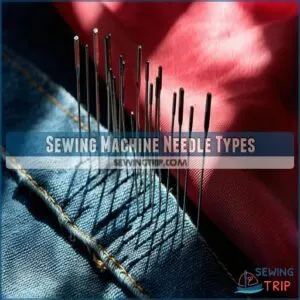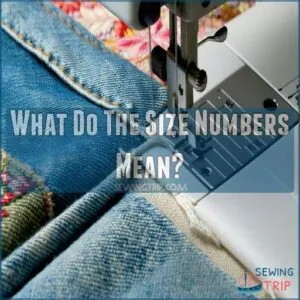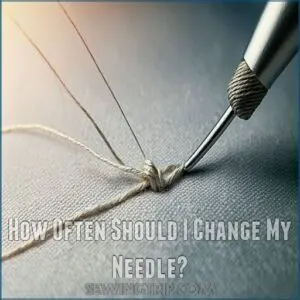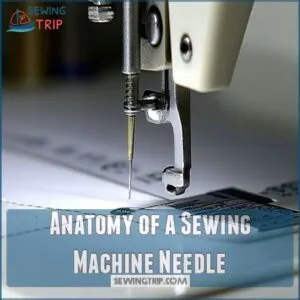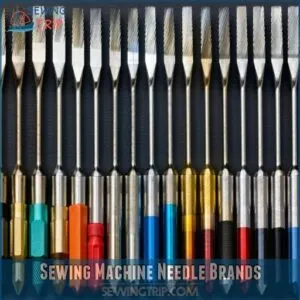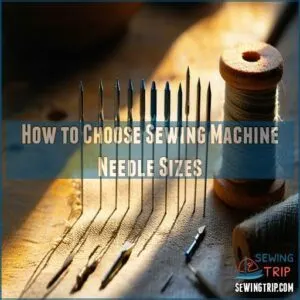This site is supported by our readers. We may earn a commission, at no cost to you, if you purchase through links.
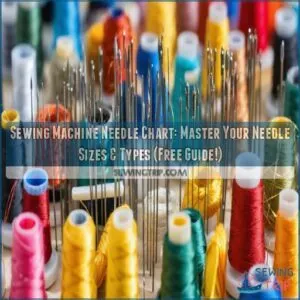 A sewing machine needle chart is like a cheat sheet for flawless stitching.
A sewing machine needle chart is like a cheat sheet for flawless stitching.
It helps you match the right needle type and size to your fabric and thread.
Universal needles, for instance, handle lightweight cotton as easily as medium-weight denim.
Ball point needles? They’re your best friends for knits, sliding through fabric without snagging.
Got stretchy Lycra? Stretch needles prevent skipped stitches, while sharp needles are your go-to for tightly woven fabrics.
Quilting needles are perfect for thick layers.
Pair the right needle with matching thread, and you’ll avoid headaches like broken stitches or puckering.
The right needle changes everything!
Table Of Contents
Key Takeaways
- Match the needle type (e.g., universal, ballpoint, stretch) and size to your fabric and thread to prevent skipped stitches, snags, and other sewing issues.
- Replace your needle after every 6-8 hours of use or when you notice wear signs, like skipped stitches or snags, to maintain smooth stitching.
- Use a needle size chart to pick the right size for your fabric; smaller sizes (e.g., 60/8) are for lightweight fabrics, while larger ones (e.g., 100/16) handle heavy-duty projects.
- Understand needle anatomy and purpose—shanks ensure alignment, while tips like sharp or ballpoint are designed for specific fabric types.
Sewing Machine Needle Types
You’ll find that choosing the right sewing machine needle is like picking the perfect dance partner for your fabric, as each type is designed to handle specific materials with precision and care.
Whether you’re working with stretchy knits or sturdy denim, understanding these needle types will help you create professional-looking stitches and prevent those frustrating skipped stitches or fabric snags.
This knowledge will allow you to create professional-looking stitches and achieve the best results in your sewing projects.
Universal Needles
Think of universal needles as your sewing Swiss Army knife – they’re the go-to choice for everyday projects.
With their slightly rounded tips, these versatile needles deliver clear, precise stitches across most woven fabrics. You’ll typically find them in sizes 80/12 or 90/14, perfect for medium-weight materials.
While they’re not specialized, their stitch quality and thread compatibility make them ideal workhorses for general sewing tasks.
For more information on sewing machine needles and their various types, considering the specific needs of your project is essential to achieve the best results.
Ball Point Needles
Smart technology meets classic craftsmanship in today’s ball point needles.
Your knits deserve special treatment – these rounded champions glide between fabric threads instead of piercing them, preventing snags and damage.
Understanding sewing techniques is essential for mastering the use of ballpoint needles and achieving professional results.
- Choose size 65-70 for delicate jersey and lightweight knits
- Perfect for sewing spandex and lycra activewear
- Ideal for looser sweater knits and stretchy fabrics
- Use with fine thread (size 120 or 150) for best results
- Works great on everything from t-shirts to lingerie
Stretch Needles
While ballpoint needles glide between fabric fibers, you’ll want stretch needles for those tricky synthetic threads and elastic materials.
These specialized needles flex perfectly with fabric tension, preventing skipped stitches and snags on Lycra, swimwear, and stretchy knits.
A selection of stretch needles is available online. They’re designed with a wider shaft and modified scarf that guarantees proper elastic recovery.
For best results, pair them with stretch stitches at moderate sewing speeds.
Sharps Needles
Sharps needles are your go-to choice when working with densely woven fabrics.
These powerhouses come with extra-strong shafts and razor-sharp needle tips that slice through multiple layers like butter.
For medium to heavy fabrics, grab sizes 2-4; lightweight materials work best with sizes 5-9.
When selecting sewing machine needles, consider the specific fabric type to guarantee peak performance.
Watch your sewing speed and thread tension – these needles can handle high-speed stitching but need proper fabric puncture technique to prevent needle breakage.
Quilting Needles
Moving from sharps to quilting needles, you’ll find these specialized tools are your best friends for tackling thick quilt sandwiches.
They’re designed with a tapered point that smoothly glides through multiple fabric layers without puckering.
For peak performance, selecting the right quilting machine needles is vital.
- Perfect for precise patchwork and intricate stitch patterns
- Features a reinforced blade that prevents needle flex
- Works beautifully with both hand-guided and machine quilting techniques
Choose your quilting needle size based on your fabric preparation and thread selection.
Quick Reference Chart
Before diving into your next project, here’s a handy sewing machine needle chart to save you from those frustrating thread breaks and skipped stitches.
| Fabric Type | Needle Size | Best Needle Type |
|---|---|---|
| Silk, Chiffon | 60/8-70/10 | Universal/Sharp |
| Cotton, Linen | 70/10-80/12 | Universal |
| Denim, Canvas | 90/14-100/16 | Denim/Sharp |
| Knits, Jersey | 70/10-80/12 | Ballpoint |
| Leather, Vinyl | 90/14-100/16 | Leather |
To achieve the best results, understanding needle types chart is vital for selecting the right needle for your project.
Think of needle selection like choosing the right shoes – you wouldn’t wear flip-flops for hiking! Match your needle to your fabric’s weight and type for perfect stitches every time.
What Do The Size Numbers Mean?
Ever wonder why your sewing machine needle has two numbers, like 90/14?
Let’s crack the code of these mysterious digits in your needle size chart!
Think of it as a bilingual conversation between European and American measurement systems.
Here’s your quick guide to understanding sewing machine needle sizes:
- European numbers (first number) show the needle’s diameter in millimeters multiplied by 100 – so a 90 means 0.9mm
- American numbers (second number) use a simpler scale from 8 to 18, with larger numbers for thicker needles
- Thread compatibility matches these numbers – finer threads need smaller numbers
- Fabric thickness guides your choice – lightweight fabrics work best with 60-70, while heavy fabrics need 100-110
- Measurement standards stay consistent across brands, making your needle size guide reliable for any project
Think of it like shoe sizes – different systems, same fit!
How Often Should I Change My Needle?
Now that you’ve got your needle sizes figured out, let’s talk about timing those needle changes perfectly.
Think of your sewing needle like a chef’s knife – it needs regular sharpening to work its magic. You’ll want to swap out that needle every 6-8 hours of sewing time, or when you notice Needle Wear Signs like skipped stitches and fabric snags.
Understanding needle replacement frequency is important for peak sewing performance.
- Remember that "just one more seam" with a worn needle can turn your silk masterpiece into Swiss cheese!
Pay attention to Sewing Frequency Impact – heavy fabrics and synthetic materials will dull your needle faster, which is crucial for maintaining peak sewing performance and preventing damage to your projects, such as turning them into Swiss cheese.
Fitting a New Needle
Changing your sewing machine needle doesn’t need to feel like brain surgery.
Start by slipping a piece of paper underneath the presser foot—this prevents the old needle from disappearing into the machine if it falls while loosening the needle screw. Once the old needle’s out, note the flat side of the new needle’s shank and face it toward the rear.
Gently push it up as high as it’ll go and tighten the screw firmly. Double-check it’s secure—loose needles can mess up thread tension or even snap mid-stitch.
Choosing the right sewing machine needle is half the battle. Double-check your sewing machine needle chart, needle size chart, and fabric prep needs before installing. A great fit equals smoother stitching, no skipped beats, and consistent machine calibration. Remember, a snugly installed needle keeps sewing speed steady and results professional.
Anatomy of a Sewing Machine Needle
Let’s talk about the anatomy of a sewing machine needle, because understanding these parts makes selecting the right needle a whole lot easier.
Think of the needle as the unsung hero of your sewing machine—small but mighty.
Here’s the breakdown:
- Needle Shank Design: This flat-on-one-side top section fits snugly into your machine, ensuring correct alignment and stability. No shank, no stitching.
- Needle Groove Function: The groove running down the shaft guides your thread smoothly through the fabric. This prevents unnecessary snags and tangles.
- Needle Eye Shape: The eye, located near the sharp end, lets the thread pass through with ease. Different shapes accommodate various threads for better results.
- Sewing Point Types: Whether it’s ballpoint for knits or sharp for silk, the needle’s tip decides how it interacts with the fabric. Precision starts here.
Master these details, and that sewing machine needle specification chart will start making perfect sense!
Sewing Machine Needle Brands
Good brands matter regarding needle performance.
Schmetz products are a go-to for durability and precision, excelling on most fabrics.
Singer quality needles, known for their strong needle materials, handle heavy fabrics effortlessly.
Janome offers specialized options, like their Blue Tip needles for embroidery or Red Tip needles for metallic threads.
Need thread compatibility with your sewing machine?
Organ needles are reliable and affordable for various sewing tasks.
Understanding industrial sewing machine needles is important for best performance.
Explore a sewing machine needle chart to compare top options from trusted sewing machine brands!
How to Choose Sewing Machine Needle Sizes
Choosing the right sewing machine needle size doesn’t have to be tricky—you just need to match it to your fabric and thread.
Think of it like finding the right tool for the job; the right size can make sewing smoother and save you from frustrating snags.
Needle Size Selection
Choosing the right needle can make all the difference.
A quick sewing machine needle sizes chart points you in the right direction: fine fabrics need a 60/8, medium ones like denim call for 90/14, and heavy-duty projects? Reach for 110/18.
Focus on fabric thickness, thread compatibility, and needle durability to keep your stitches perfect, no matter the sewing speed.
Needle Type Considerations
Matching needle types to your project guarantees fabrics glide smoothly, threads don’t snap, and stitches hold strong.
Here’s a quick look at needle type considerations:
- Universal needles: Perfect all-rounders.
- Ballpoint: Gentle on knits and stretchy fabrics.
- Denim: Tough for heavy-duty materials.
- Leather: Wedge-shaped for piercing leather.
- Stretch: Designed for slippery, elastic fabrics.
Check a sewing machine needle chart for precise compatibility!
Proper Needle Replacement
Over time, needles wear out, causing skipped stitches or dull fabric penetration.
Keep an eye out for needle wear signs like snagging threads or a popping sound.
Replace needles every 8 hours of use for sewing performance optimization.
Store spares correctly to avoid damage.
Regular needle replacement and quick machine maintenance checks can make all the difference—it’s in the sewing needle size chart!
Frequently Asked Questions (FAQs)
What is a sewing machine needle size chart?
Size, strength, and stitch success—it all starts with the sewing machine needle size chart.
It guides you to pick the perfect needle for every fabric and thread combo, ensuring smooth sewing and frustration-free results.
What is a sewing machine needle guide?
A sewing machine needle guide helps you choose the perfect needle for your project.
It explains needle types, sizes, and their fabric compatibility, making sewing easier, improving stitch quality.
It prevents avoidable headaches like broken needles.
How do you identify a sewing machine needle?
Did you know dull needles cause nearly 90% of skipped stitches?
Check yours by looking for a flat shank, groove along the shaft, and carefully inspecting the eye and tip for wear or damage.
How many needles are in a sewing machine?
A sewing machine typically uses just one needle at a time.
It’s all about matching the needle setup to your project’s needs—simple but essential!
What are the different types of sewing machine needles?
Think of sewing needles as specialized tools for different jobs—universal needles handle everyday sewing, while ballpoint needles love knits.
Stretch, sharp, denim, quilting, leather, and topstitching needles are designed for specific fabrics and techniques.
What do sewing machine needle numbers mean?
Sewing machine needle numbers explain thickness.
Smaller numbers mean thinner needles for lighter fabrics, while larger numbers work with heavy-duty fabrics.
For example, a 70/10 needle suits lightweight cotton, and 90/14 handles denim effortlessly.
How do I know what sewing machine needle to use?
Don’t let the wrong needle ruin your project!
Match the needle to your fabric—use ballpoint for knits, sharp for wovens, and heavy-duty for denim.
Check thread fit and size for smooth stitching.
What is a 90 14 needle used for?
A 90/14 needle works great for medium-weight fabrics like denim, corduroy, or quilting cotton.
It’s sturdy enough to handle tougher threads and layers without breaking, making it an all-around champ for everyday sewing projects.
What is an 80/12 needle used for?
An 80/12 needle is perfect for lightweight to medium-weight fabrics like cotton, polyester, and linen.
It’s a go-to for most projects, handling standard sewing threads while keeping stitches crisp and clean.
What is a 100/16 needle used for?
A 100/16 needle works best for heavy fabrics like denim, canvas, or upholstery.
Its thicker size handles durable threads and tough materials without breaking.
Perfect when sewing curtains, heavy bags, or your next DIY project.
Conclusion
Imagine a stitch so perfect it’s like the fabric agreed to cooperate.
That’s the magic of choosing the right needle from a sewing machine needle chart. Whether you’re tackling stretchy fabrics, cozy knits, or stubborn denim, matching needle type and size to your project transforms your sewing experience.
Keep experimenting with needle choices, swapping them out when needed, and watch your stitches improve every time. Your creativity deserves the best tools—start with the perfect needle!
- https://www.sewessential.co.uk/blog/how-to-choose-the-right-sewing-machine-needle/
- https://blog.treasurie.com/sewing-machine-needle-sizes/
- https://www.thesewingdirectory.co.uk/sewing-machine-needle-guide/
- https://www.sewjersey.com/blogs/quilting-tips/what-do-sewing-machine-needle-sizes-mean
- https://www.schmetzneedles.com/pages/sewing-machine-needle-chart

